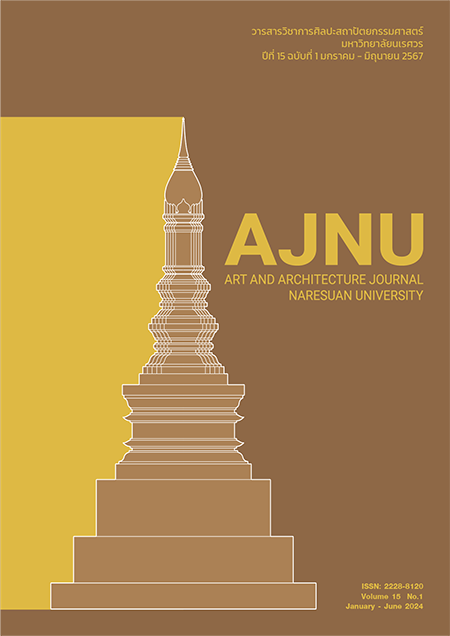Display design guidelines for the elderly
Main Article Content
Abstract
Today, the concept of museum design that realizes design for all including the elderly. were considered more. The objectives of this research were 1. to classify the display types in the museum 2.to assess the elderly's satisfaction with each display type. The total number of participants in the study was 16, comprising 9 elderly (aged 60 to 81 years) and 7 adults (aged 25 to 45 years). Selection of informants was done by purposive random sampling technique. The study area, Coin Museum (Bang-Lamphu area), is a 3-storey building with 14 exhibition rooms and includes all types of displays. Admission to the museum will be in groups of 15-20 people each with a guide. Data collection started with all research participants visiting the Coin Museum as usual, after which the visit was a survey form and in-depth interview process. The survey form, all 21 displays were assessed in three areas: absorbed, active, and enlightened. It is divided into 9 questions. Results: The researcher categorized the display into 5 categories, namely object, board, multimedia, interactive, and scene, including 21 display types (D1-D21). The assessment of the elderly's satisfaction with display found that the interactive category received the highest satisfaction, followed by scene, multimedia, object, and board. The elderly considers the absorbed aspect followed by the active aspect. In addition, the researchers conducted a comparative analysis of satisfaction between the elderly and the adult. It was found that the order of display types was no different. However, when looking at the insights of each display, there are noticeable differences. The findings in this research will build understanding between display designers and the elderly. Including the adult group and can bring further knowledge to the research on museum design for the elderly in the future.
Article Details

This work is licensed under a Creative Commons Attribution-NonCommercial-NoDerivatives 4.0 International License.
References
ชีวสิทธิ์ บุญยเกียรติ. (2559). ปฏิบัติการพิพิธภัณฑ์: บทเรียนจากคนอื่น. กรุงเทพฯ: สถาบันพิพิธภัณฑ์การเรียนรู้แห่งชาติ.
ชัยณรงค์ อริยะประเสริฐ และ วีรยา เอี่ยมฉ่ำ. (2556). คู่มือมาตรฐานการนำเสนอเนื้อหาของพิพิธภัณฑ์แหล่งเรียนรู้ในอาคาร
สาธารณะ ด้วยการออกแบบที่เป็นธรรมสำหรับทุกคน (Universal design). กรุงเทพฯ: สำนักงานกองทุนสนับสนุนการ
สร้างเสริมสุขภาพ.
สมัชชา อภิสิทธิ์สุขสันต์. (2558). การออกแบบสื่อนิทรรศการเพื่อผู้พิการทางสายตาในพิพิธภัณฑ์ท้องถิ่นกรุงเทพฯ (ศป.ม.).
กรุงเทพฯ: มหาวิทยาลัยศิลปากร.
สิรินธร สินจินดาวงศ์ และผุสดี กลิ่นเกสร. (2563). การเรียนรู้ตลอดชีวิตสำหรับผู้สูงอายุ. การประชุมวิชาการและเผยแพร่
ผลงานวิจัยคัดสรรสาขาวิชาศึกษาศาสตร์ระดับชาติ หัวข้อ การศึกษายุค “Digital Disruption in Education”.
(น.1-15). นครราชสีมา: สมาคมสถาบันอุดมศึกษาเอกชนแห่งประเทศไทย ในพระราชูปถัมภ์.
สำนักงานคณะกรรมการการศึกษาแห่งชาติ. (2546). รายงานวิจัยปฏิบัติการพัฒนาระบบประกันคุณภาพภายในสถานศึกษา.
กรุงเทพฯ: โรงพิมพ์องค์การรับส่งสินค้าและพัสดุภัณฑ์.
Chatterjee, Helen J., Sonjel Vreeland, and Guy Noble. (2009). Museopathy: Exploring the healing potential of
handling museum objects. Museum and Society, 7(3), 164–177.
Cohen, Gene D., and The Center on Aging, Health & Humanities. The George Washington University (GW). (2006).
The creativity and aging study: The impact of professionally conducted cultural programs on older
adults. Washington DC: National Collaborative on Aging Faculty Publications. Accessed March 2021.
http://hsrc.himmelfarb.gwu.edu/son_ncafacpubs/2
Goulding, C .(2000). The museum environment and the visitor experience. European Journal of Marketing,
(3/4), 261-278. https://doi.org/10.1108/03090560010311849
Stephen Bitgood. (1994). Design Effective Exhibits: Criteria for Success, Exhibit Design Approaches, and Research
Strategies. Visitor Behavior, 4(4), 4-15.


